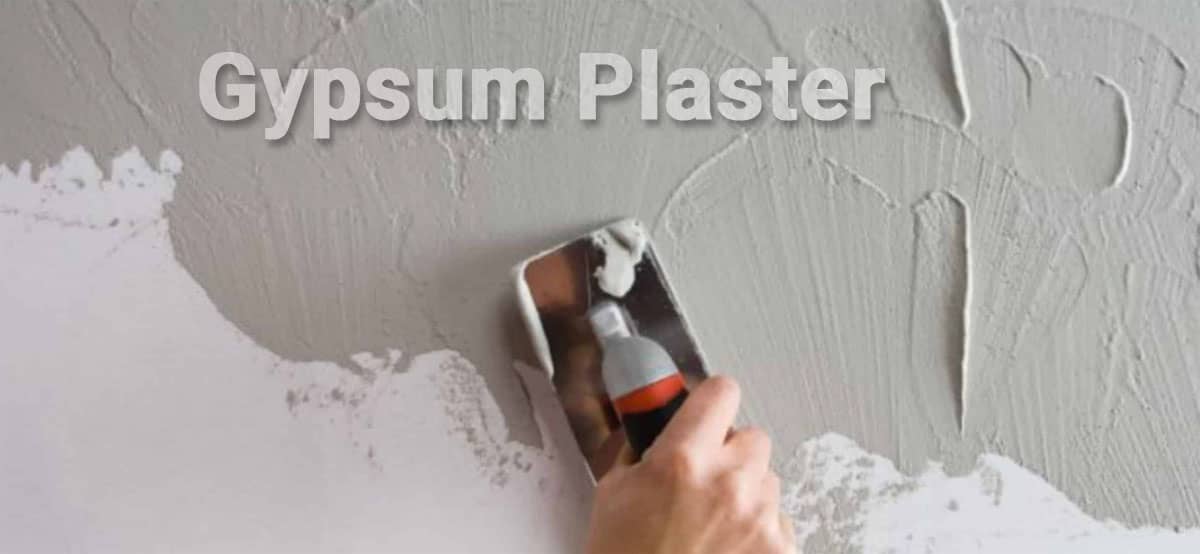A Brief Note on Gypsum Plaster

Gypsum plaster has gained popularity over the past few decades and largely replaced lime and cement plasters. Plastering is an ancient finish that has been used by mankind for thousands of years. Brick or block masonry gives a smooth surface to make it more visually appealing.
In addition to being beautiful, plastering also provides a protective covering for bricks and stones. Plasters use in various ways in different works, based on desired finishes, ingredients, popularity, and required proportions. Various types of plaster are available in the market, such as cement plaster, lime plaster, clay plaster, mud plaster, and gypsum plaster.
Gypsum Plaster
Calcium sulfate dehydrate makes up the soft sulfate mineral Gypsum. Rocks comprised of this mineral are white. In addition to the use in fertilizers, molds, sculptures, and plaster, it has many other applications.
A naturally occurring water-soluble mineral, gypsum is known to chemists as hydrous calcium sulfate. It is crystalline.
Workflow
Due to its lightweight, its use for plastering does not add structural load to a building. Unlike cement plaster, gypsum plaster does not shrink when it is dried and hardened. That reinforces the hardness of the plaster and makes it easier to work with. A large amount of crystallized water is present in gypsum, making it non-combustible. If a fire breaks out, it protects the blocks, concrete, and steel. A plaster of gypsum prevents pipes from rusting and increases their durability. As a low thermal conductor, gypsum plaster can reduce energy consumption and save money. The tensile and flexural strength of Gypsum plaster is excellent.
Method of Application of Gypsum
Gypsum is found in thick sedimentary rock beds, lakes, and rivers, where it is deposited by seawater or saltwater.
Lake and seawater constantly deposit Gypsum, and since it is a naturally occurring substance, it is not potentially harmful to the environment. This model is not environmentally sustainable since the sand required for sand cement plaster comes from river beds. Sand cement plaster does not pose any major health risks.
Uses of Gypsum
Gypsum uses in many other industries such as medical, fertilizers, and agriculture. The use of gypsum plaster is simple and does not require a lot of skilled labor, unlike the traditional cement mortar. A smooth finish can be achieved with Gypsum plaster and is an excellent base for high-quality paints and wallpapers. Almost all types of surfaces can cover with gypsum plaster.
Benefits of Gypsum Plaster
- In comparison with cement reactions with water, the gypsum reaction produces less heat. Hence, gypsum plaster is less prone to shrinkage cracks than cement plaster.
- After drying, this material has excellent high strength, is durable, and is light.
- A gypsum wall covering improves the acoustics in your home, which means fewer echoes and less outside interference. To reduce outside noise and improve acoustics, soundproof rooms use Gypsum boards sandwiched between walls.
- The waiting period for gypsum plastering is much shorter. The drying and setting of plaster take three days. So construction can proceed at a faster pace. If the building is multistory, construction time is substantially reduced. Plastering with gypsum takes just three days as opposed to 21 days for conventional sand cement plaster. Plastering with gypsum saves construction time.
- Gypsum is an excellent heat insulation material, so it can help you keep your room at a steady temperature, reducing your energy bills.
Drawbacks of Gypsum Plaster
- Weather, moisture, or high humidity should not be avoided when using gypsum plaster.
- It is not possible to plaster with gypsum in areas that are continuously damp, such as a bathroom.
- Traditional cement mortar plaster is more expensive than gypsum plaster.
- Plaster made of gypsum is more expensive than plaster made of cement for the same thickness. Gypsum plaster, however, would be an economical alternative in areas where river sand is hard to come by.
- Finish coats containing lime should not be painted over primers containing polyvinyl acetate the bond between the primers and the plaster may fail to cause the primer coat and subsequent finish coats to come away from surfaces due to the alkalinity of the plaster.
Conclusion
There are rather thick deposits of gypsum on Earth's surface in layers of limestone and shale, as well as under ancient salt deposits in the Earth's crust formed as ancient seas evaporated. Gypsum plaster's strength and setting time decreased when it exposes to moisture. A dry platform made from wood, brick, or concrete needs as an elevated platform for storing gypsum bags. Gypsum plaster usually has a shelf life of three to four months after its manufacturing. A properly stored product can have a shelf life of up to 6 months if stored under the right conditions of temperature and humidity.
